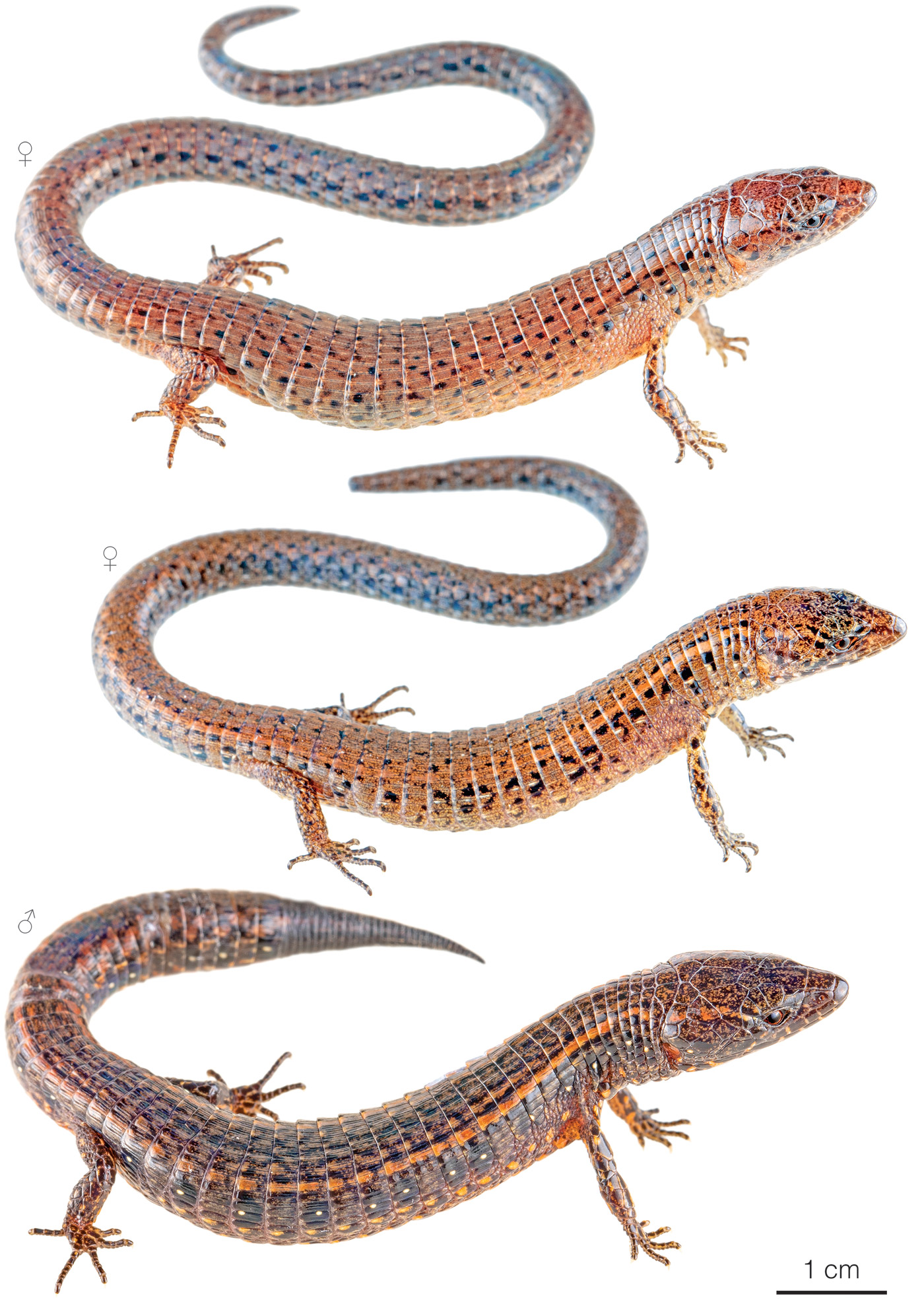Published December 6, 2020. Updated November 17, 2023. Open access. Peer-reviewed. | Purchase book ❯ |
El Oro Andean-Lizard (Andinosaura aurea)
Reptiles of Ecuador | Sauria | Gymnophthalmidae | Andinosaura aurea
English common name: El Oro Andean-Lizard.
Spanish common name: Lagartija andina de El Oro.
Recognition: ♂♂ 16.4 cmMaximum distance from the snout to the tip of the tail. Snout–vent length=5.7 cm. ♀♀ 14.9 cmMaximum distance from the snout to the tip of the tail. Snout–vent length=5.2 cm.. Andinosaura aurea differs from all other lizards in its area of distribution by lacking prefrontal scales and having extremities so short that the front and hind limbs do not overlap when pressed against its body.1 Adult males are more robust than females and are easily recognizable by their darker dorsal coloration and flanks having ocelli consisting of a black circle with a white spot in the middle (Fig. 1). Adult females are brownish overall and lack ocelli.

Figure 1: Individuals of Andinosaura aurea from Guanazán, El Oro province, Ecuador.
Natural history: Andinosaura aurea is a rarely seen cryptozoic (preferring moist, shaded microhabitats) lizard that inhabits old-growth to heavily disturbed evergreen high montane forests, cloud forests, herbaceous páramos, dry montane scrubs, and areas containing a mixture of pastures and remnants of native vegetation.1,2 El Oro Andean-Lizards spend most of their lives hidden under soft soil, rocks, and ground material,2 but one individual was found on a branch 10 cm above the ground next to an unpaved road.1 When threatened, individuals of A. aurea will quickly flee under cover. If captured, they may bite or readily shed the tail.2
Conservation: Endangered Considered to be facing a high risk of extinction in the near future.. Andinosaura aurea is proposed to be assigned in this category, instead of Vulnerable,3 following IUCN criteria4 because the species is known from only four populations and is restricted to a small (~431 km2) area that has lost approximately 72.6% of its natural vegetation cover. The habitat of A. aurea is severely fragmented and continues to decline in extent and quality due to encroaching human activities such as agriculture, cattle grazing, and the replacement of native vegetation with eucalyptus and pine trees.3,5
Distribution: Andinosaura aurea is endemic to an area of approximately 431 km2 along the Pacific slopes of the Andes in southwestern Ecuador (Fig. 2).

Figure 2: Distribution of Andinosaura aurea in Ecuador. The star corresponds to the type locality: Guanazán, El Oro province. See Appendix 1 for a complete list of the presence localities included in the map.
Etymology: The generic name Andinosaura, which comes from the Spanish word andino (from the Andes) and the Latin sauria (=lizard), refers to the distribution of this group of lizards.6 The specific epithet aurea is derived from the Latin word aurum, which means “gold.”7 It refers to the provenance of the species: El Oro (meaning “gold” in Spanish) province.1
See it in the wild: El Oro Andean-Lizards are recorded rarely unless they are actively searched for by digging in areas of soft soil or by turning over rocks and logs. Around the town Guanazán, El Oro province, individuals can be found reliably if the search is targeted and carried out for a period of at least four hours.
Acknowledgments: This account was published with the support of Secretaría Nacional de Educación Superior Ciencia y Tecnología (programa INEDITA; project: Respuestas a la crisis de biodiversidad: la descripción de especies como herramienta de conservación; No 00110378), Programa de las Naciones Unidas (PNUD), and Universidad San Francisco de Quito (USFQ).
Author: Alejandro ArteagaaAffiliation: Fundación Khamai, Reserva Arlequín, Ecoruta Paseo del Quinde km 56, Santa Rosa de Mindo, Pichincha 171202, Ecuador.
Academic reviewer: Jeffrey D CamperbAffiliation: Department of Biology, Francis Marion University, Florence, USA.
Photographers: Jose VieiracAffiliation: Tropical Herping (TH), Quito, Ecuador.,dAffiliation: ExSitu, Quito, Ecuador.
How to cite? Arteaga A (2023) El Oro Andean-Lizard (Andinosaura aurea). In: Arteaga A, Bustamante L, Vieira J (Eds) Reptiles of Ecuador: Life in the middle of the world. Available from: www.reptilesofecuador.com. DOI: 10.47051/PZSE8930
Literature cited:
- Sánchez-Pacheco SJ, Aguirre-Peñafiel V, Torres-Carvajal O (2012) Lizards of the genus Riama (Squamata: Gymnophthalmidae): the diversity in southern Ecuador revisited. South American Journal of Herpetology 7: 259–275. DOI: 10.2994/057.007.0308
- Field notes, Reptiles of Ecuador book project.
- Cisneros-Heredia DF, Valencia J, Brito J, Almendáriz A, Muñoz G (2017) Riama aurea. The IUCN Red List of threatened species. Available from: www.iucnredlist.org. DOI: 10.2305/IUCN.UK.2017-2.RLTS.T50950460A50950463.en
- IUCN (2012) IUCN Red List categories and criteria: Version 3.1. Second edition. IUCN Species Survival Commission, Gland and Cambridge, 32 pp.
- Lewis TR (2002) Threats facing endemic herpetofauna in the cloud forest reserves of Ecuador. Herpetological Bulletin 79: 18–26. DOI: 10.5281/zenodo.3744655
- Sánchez‐Pacheco SJ, Torres‐Carvajal O, Aguirre‐Peñafiel V, Sales-Nunes PM, Verrastro L, Rivas GA, Rodrigues MT, Grant T, Murphy RW (2017) Phylogeny of Riama (Squamata: Gymnophthalmidae), impact of phenotypic evidence on molecular datasets, and the origin of the Sierra Nevada de Santa Marta endemic fauna. Cladistics 34: 260–291. DOI: 10.1111/cla.12203
- Brown RW (1956) Composition of scientific words. Smithsonian Books, Washington D.C., 882 pp.
Appendix 1: Locality data used to create the distribution map of Andinosaura aurea in Ecuador (Fig. 2). Go to the section on symbols and abbreviations for a list of acronyms used. Asterisk (*) indicates type locality.
| Country | Province | Locality | Source |
| Ecuador | El Oro | Chivaturco | INABIO 2019 |
| Ecuador | El Oro | El Chiral | Sánchez-Pacheco et al. 2012 |
| Ecuador | El Oro | El Panecillo | Sánchez-Pacheco et al. 2012 |
| Ecuador | El Oro | Guanazán* | Sánchez-Pacheco et al. 2012 |
| Ecuador | El Oro | Guizhaguiña | Sánchez-Pacheco et al. 2012 |